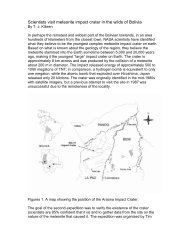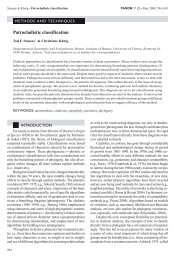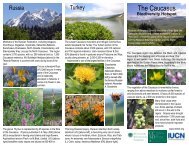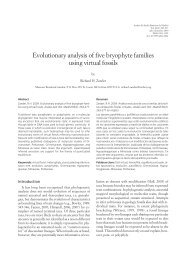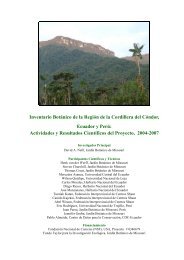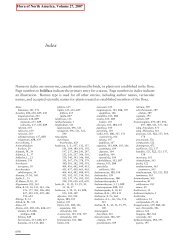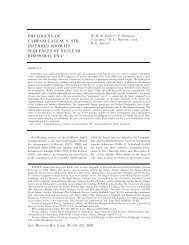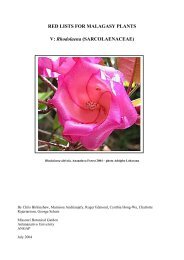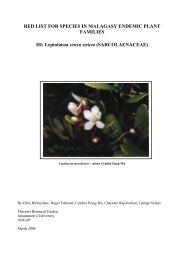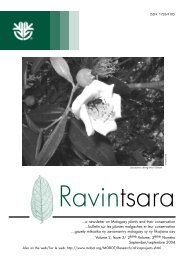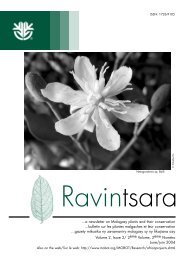red lists for malagasy plants iv: sphaerosepalaceae - Missouri ...
red lists for malagasy plants iv: sphaerosepalaceae - Missouri ...
red lists for malagasy plants iv: sphaerosepalaceae - Missouri ...
Create successful ePaper yourself
Turn your PDF publications into a flip-book with our unique Google optimized e-Paper software.
Rhopalocarpus alternifolius (Baker) Capuron Risk of extinction: Least Concern (although the population of<br />
this species is p<strong>red</strong>icted to decline it has several large and<br />
Vernacular names: Andrengitra, Fanavimaintso,<br />
Hafotrakora, Lombiro, Mantaditra<br />
Description:<br />
Large tree. Leaves medium, venation pinnate, with densely<br />
packed and almost parallel secondary veins, coriaceous.<br />
Inflorescence a many-flowe<strong>red</strong> panicle. Flower with 4<br />
sepals, 4 white petals, many stamens. Fruit large,<br />
woody/fleshy, globose/lobed, with smooth surface.<br />
Habitat:<br />
• Vegetation type: low elevation evergreen <strong>for</strong>est, dry<br />
deciduous <strong>for</strong>est<br />
• Bioclimate: humid, subhumid<br />
• Geology: basement rock, mesozoic limestone, lava<br />
• Altitude: 3 - 1,000 m<br />
Biology:<br />
• Pollination: probably insect (on basis of flower<br />
characteristics also bees seen visiting the flowers of R.<br />
parvifolius and Rhopalocarpus suarezensis)<br />
• Seed dispersal: probably lemurs (Iambana Bernard (pers.<br />
comm.) reports that the fruits of this species are eaten by V.<br />
variegata and Eulemur fulvus at Betampona RN)<br />
Uses:<br />
Timber<br />
Distribution:<br />
apparently secure sub-populations within protected areas).<br />
Conservation recommendations: good management of<br />
protected areas<br />
Observations of study population(s)<br />
• Location: Betampona RN (17.55.55S, 49.12.11E)<br />
• Regeneration observed: Yes<br />
• Tolerant to disturbance: no<br />
• Density: 2 mature ind<strong>iv</strong>idual per ha.<br />
• Abundance: 2,500 – 10,000 mature ind<strong>iv</strong>iduals<br />
P<strong>red</strong>icted future decline:<br />
• because of habitat loss: 30-50 % (cause of loss = tavy)<br />
• because of exploitation or poor regeneration: unknown, but<br />
decline possible because of exploitation and poor regeneration<br />
resulting from increasing rarity of animal seed dispersers.<br />
Distribution attributes <strong>for</strong> population<br />
• Extent of occurrence: 76962 km²<br />
• Area of occupancy: 38067 km²<br />
• Number of subpopulations: 12<br />
Representation in protected areas:<br />
• Number of subpopulations: 6<br />
• Protected areas: Ankarana RS, Betampona RN, Mananara<br />
Nord BR, Manongar<strong>iv</strong>o RS, Masoala PN, Montagne d’Ambre<br />
PN.<br />
Specimens examined: Madagascar : R. Baron 2412. Antsiranana: Masoala PN, R. Bernard et al. 42 ; Manongar<strong>iv</strong>o RS, SF(R. Capuron) 11507 ; Ankarana<br />
RS, SF(R. Capuron) 18997 ; Ankorefo, SF(R. Capuron) 11346 ; Ankarana RS, SF(Rakotosihanaka,J.) 10667 ; Ankarana RS, SF(Rakotosihanaka,J.) 10705 ;<br />
Les Roussettes SF, SF(R-152) 205-R-152 ;Tsihomanaomby massif, C. Birkinshaw et al. 730 . Toamasina ; Ambanizana, G.E. Schatz & G. Modeste 3070 ;<br />
Betampona RN, SF(R. Capuron) 18133 ; Fampanambo, SF(R. Capuron) 18293 ; Menagisy, SF(Goyeneche) 12359 ; Tampolo STF, SF(Zavan P.) 16016 ;<br />
Betampona, RN(Rajanoparamy) 9047 ; Manahar, H. Humblot 201 ; Betampona RN, B. Iambana & Arsène 226<br />
15





